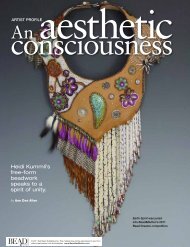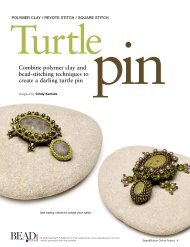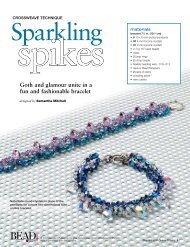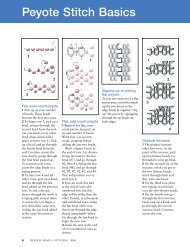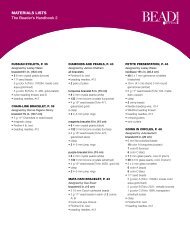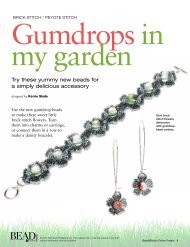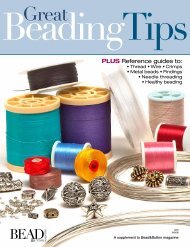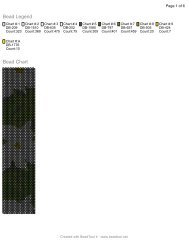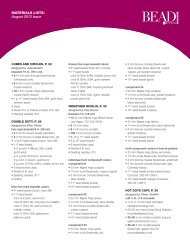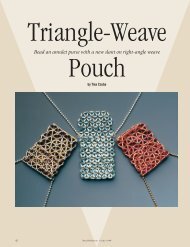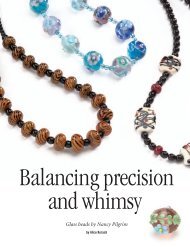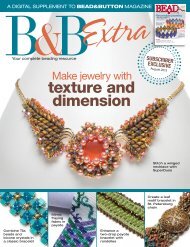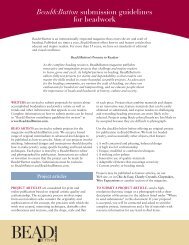Karen Paust - Bead and Button Magazine
Karen Paust - Bead and Button Magazine
Karen Paust - Bead and Button Magazine
Create successful ePaper yourself
Turn your PDF publications into a flip-book with our unique Google optimized e-Paper software.
natural<br />
treasure<br />
With a background in botany, artist<br />
<strong>Karen</strong> <strong>Paust</strong><br />
set out to bead every plant<br />
<strong>and</strong> insect that crossed her path<br />
by Pam O’Connor<br />
Photo by John Klunk<br />
As I enter a driveway in rural Pennsylvania, I’m uncertain<br />
whether I’ve found the right place, since I can’t see a<br />
house. As I proceed, a rabbit scuttles in front of my car<br />
<strong>and</strong> hops down the center of the driveway, over a rise, <strong>and</strong><br />
into a wooded hollow, where I find <strong>Karen</strong> <strong>Paust</strong>’s house.<br />
Before<br />
<strong>Paust</strong>’s two-year<br />
hiatus from<br />
beading, she<br />
was working on<br />
moths. This year<br />
she picked up<br />
where she left<br />
off, completing<br />
two tiger moths.<br />
Creative childhood<br />
Painting, drawing, knitting, papermaking,<br />
sewing, ceramics,<br />
gardening, cooking: You’d be hardpressed<br />
to find a creative pursuit<br />
that isn’t part of <strong>Paust</strong>’s repertoire.<br />
Our conversation w<strong>and</strong>ers over granola<br />
recipes, hunting for morels, <strong>and</strong><br />
starting plants from seed before we<br />
settle down to the topic at h<strong>and</strong>:<br />
how she became a beader.<br />
“I’ve always been a creative<br />
person,” says <strong>Paust</strong>. “I made doll<br />
clothes when I was six. All I wanted<br />
<strong>Paust</strong>’s mobile titled Pond<br />
features five distinctly different<br />
goldfish suspended from actual<br />
roots <strong>and</strong> vines. Five insects,<br />
including two dragonflies,<br />
hover above the fish.<br />
Photo by T.E. Crowley<br />
to do as a child was make things.”<br />
<strong>Paust</strong>’s urge to create was nurtured<br />
by her mother <strong>and</strong> gr<strong>and</strong>mother.<br />
Their ability to sew, knit, <strong>and</strong> spin<br />
was vital to their survival in a<br />
destitute East German town during<br />
<strong>and</strong> after World War II.<br />
Such austerity wasn’t part of<br />
<strong>Paust</strong>’s childhood, but it’s evident<br />
she takes great pride in <strong>and</strong> even<br />
inspiration from the self-reliance<br />
<strong>and</strong> resourcefulness that sustained<br />
her relatives through hard times.<br />
Discovering her artistry<br />
“When I left for college, I had never<br />
had any art classes,” she says. “I<br />
was studying botany at Purdue<br />
University, <strong>and</strong> I enrolled in a basic<br />
design class for fun. That class<br />
changed everything. I just loved it. I<br />
realized that every time I looked<br />
through the microscope at cells, I<br />
was more interested in the colors<br />
<strong>and</strong> shapes <strong>and</strong> doing the drawings<br />
than in the scientific aspects.”<br />
<strong>Paust</strong> went home <strong>and</strong> told her<br />
parents that she had to go to art<br />
school. She enrolled in summer art<br />
classes so she could assemble a portfolio<br />
<strong>and</strong> was accepted at the Maryl<strong>and</strong><br />
Institute College of Art.<br />
“When I got there, I had all my<br />
academic requirements finished, so<br />
all I had to do was draw <strong>and</strong> paint<br />
for three-<strong>and</strong>-a-half years,” she says.<br />
<strong>Bead</strong>s become her medium<br />
After graduation, <strong>Paust</strong> got a job in<br />
a gallery in York, Pennsylvania.<br />
Making a living as an artist was a<br />
struggle, but her frugal lifestyle led<br />
her to beads. “I couldn’t afford to<br />
buy jewelry, so I bought beads to<br />
make myself simple earrings,” she<br />
recalls. “I played around with the<br />
beads <strong>and</strong> realized they fit together<br />
like cells. I saw that I could make<br />
anything I wanted. Without knowing<br />
what I was doing, I taught myself<br />
peyote stitch.”<br />
At that point in the early 1980s,<br />
there were no books to consult or<br />
beading classes to take, so <strong>Paust</strong><br />
improvised through trial <strong>and</strong> error,<br />
intuiting the stitches. She says, “It’s<br />
worked to my advantage that I<br />
wasn’t exposed to conventional<br />
jewelry making <strong>and</strong> beading. I just<br />
jumped in with what I knew about<br />
cellular <strong>and</strong> molecular structure.”<br />
When she wore her jewelry creations,<br />
people asked her where she<br />
had bought them, so she started to<br />
sell her work in stores <strong>and</strong> galleries.<br />
But she really wanted to make beaded<br />
paintings. “I was interested in<br />
making large pieces that light could<br />
shine through,” she says. This desire<br />
also inspired her to make mobiles.<br />
116 <strong>Bead</strong>&<strong>Button</strong> | bead<strong>and</strong>button.com
“I love my mobiles. They are my<br />
favorite things,” says <strong>Paust</strong>. It’s no<br />
wonder <strong>Paust</strong> is partial to them.<br />
With creations so lifelike, they only<br />
need the animation of a breeze to<br />
complete the illusion.<br />
“As an artist, I don’t really categorize<br />
myself,” she says. “For me, it<br />
is important to explore all types of<br />
mediums <strong>and</strong> be open to evolving. I<br />
keep a journal to sketch <strong>and</strong> write<br />
down poems, dreams, <strong>and</strong> ideas,<br />
which can materialize into beaded<br />
pieces, paintings, sculptures, knitted<br />
sculptures, or wearable pieces.”<br />
>> In the neckpiece Autumnal<br />
Equinox, the elements are so<br />
lifelike that the sunflower<br />
dazzles even when viewed from<br />
the back. <strong>Paust</strong> doesn’t stint<br />
on the flower’s sepals any more<br />
than she would on its petals.<br />
Photo by T.E. Crowley<br />
Across the country <strong>and</strong> back<br />
Looking to exp<strong>and</strong> her horizons,<br />
<strong>Paust</strong> moved to Santa Barbara,<br />
California, in 1988. “I wanted an<br />
adventure,” she says. “But it was<br />
difficult being an artist in Southern<br />
California. I had three jobs to pay<br />
the rent <strong>and</strong> very little time to work<br />
on my beading.”<br />
Then, a wildfire swept through<br />
her neighborhood, <strong>and</strong> <strong>Paust</strong> lost<br />
everything. All her beadwork went<br />
up in smoke, except five pieces she<br />
had sent to be photographed for<br />
publication.<br />
Word got out through Alice<br />
Scherer’s beading newsletter about<br />
<strong>Paust</strong>’s ordeal. No sooner had the<br />
item appeared than <strong>Paust</strong> began<br />
receiving packages of beads. “It was<br />
like Christmas,” she recalls. “For<br />
months afterwards I received small<br />
parcels <strong>and</strong> encouraging notes.”<br />
Despite the support, it was time<br />
to return to Pennsylvania. With<br />
more time to focus on her beadwork,<br />
she received more recognition.<br />
Her carefully wrought pieces<br />
attracted collectors, <strong>and</strong> the Mobilia<br />
Gallery in Cambridge, Massachusetts,<br />
<strong>and</strong> Julie Artisans’ Gallery in<br />
New York began to represent her.<br />
In her studio<br />
We’ve finished our tea, <strong>and</strong> <strong>Paust</strong><br />
invites me down to her studio. A tall<br />
cabinet holds a splendid assortment<br />
of beads, ordered by hue. There are<br />
pots of crochet <strong>and</strong> knitting needles,<br />
jars of buttons, even a container of<br />
cast-off beaded insects, leaves, <strong>and</strong><br />
Of her Spring<br />
in the Woods<br />
neckpiece, <strong>Paust</strong><br />
says, “On a springtime hike, I<br />
came across a Luna moth that had<br />
just emerged from its cocoon <strong>and</strong><br />
was drying its wings. I thought it<br />
would be challenging to bead a<br />
neckpiece with the moth <strong>and</strong> the<br />
early-spring flowers that were blooming.”<br />
flowers that didn’t make the cut. She<br />
dumps them out <strong>and</strong> sorts through<br />
them, pointing out what failing<br />
made her ab<strong>and</strong>on each one.<br />
<strong>Paust</strong> then demonstrates her<br />
favorite way to bead: st<strong>and</strong>ing up<br />
with her beadwork perched on a<br />
chin-high windowsill.<br />
“It’s the most comfortable way<br />
for me to work because the beads<br />
are right at eye level <strong>and</strong> the light is<br />
good,” she explains, laughing a bit<br />
because of how unusual it looks.<br />
A few of her bead paintings hang<br />
on the wall, <strong>and</strong> I stop to admire one.<br />
Photo by T.E. Crowley<br />
>> In Trying to Root, a surreal figure – half woman, half<br />
carrot – is planted among common plants – sunflower, thistle,<br />
thorn apple, morning glory, wisteria, <strong>and</strong> beet. <strong>Paust</strong> uses a<br />
pointillist comm<strong>and</strong> of the color spectrum in this portrayal,<br />
dappling the carrot woman’s skin with purple, red, <strong>and</strong> green.<br />
“I love beads because they are the<br />
perfect medium to illustrate the way<br />
the universe is made of tiny bits of<br />
energy,” she says. I’d venture that<br />
<strong>Paust</strong>’s studio buzzes with such<br />
energy. After a joyful farewell, I<br />
leave <strong>Paust</strong> to return to the moth or<br />
wherever her boundless creative<br />
energy leads. w<br />
Contact <strong>Karen</strong> <strong>Paust</strong> in care of<br />
<strong>Bead</strong>&<strong>Button</strong>, or visit her website,<br />
www.karenpaust.com, scheduled to<br />
debut in early September. Contact<br />
Pam O’Connor at pampal@msn.com.<br />
Photo by T.E. Crowley<br />
bead<strong>and</strong>button.com | October 2006 117
Create beautiful jewelry with<br />
<strong>Bead</strong>&<strong>Button</strong> magazine<br />
With every issue of<br />
<strong>Bead</strong>&<strong>Button</strong> magazine<br />
you’ll get 28+ projects, complete<br />
with step-by-step instructions,<br />
detailed photographs, <strong>and</strong><br />
illustrations. Let <strong>Bead</strong>&<strong>Button</strong><br />
bring endless imagination<br />
<strong>and</strong> possibilities to your<br />
jewelry making!<br />
Subscribe<br />
TODAY!<br />
05X1012<br />
Order online at<br />
www.bead<strong>and</strong>button.com/promo<br />
Enter code I4D2 or call 800-533-6644<br />
Monday-Friday, 8:30 am - 5:00 pm Central Time. Outside the U.S. <strong>and</strong> Canada, call 262-796-8776.



